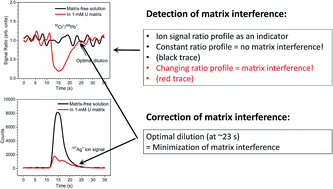Detection and correction of matrix interference in inductively coupled plasma – time of flight mass spectrometry by means of aerosol dispersion
Abstract
The time-dependent ratio of two ion signals is used to indicate and correct for mass-dependent matrix interference in inductively coupled plasma-time of flight mass spectrometry. A plug of sample solution is injected into the nebulizer in an air carrier by means of a two-position flow-injection valve. Because of dispersion in the spray chamber, all species in the sample then yield the same time-dependent concentration profiles. In the absence of a matrix interference, the signal profiles also match, and produce a constant ratio. In contrast, the presence of a mass-dependent matrix interference causes the ratio of two ion signals to deviate from a constant value. The inconsistent ratio then serves as an indicator of the presence of a matrix interference. Four ion pairs (51V+/55Mn+, 59Co+/107Ag+, 55Mn+/208Pb+, and 52Cr+/208Pb+) are examined in the present study and reveal that ion pairs having a large mass difference serve best for the detection of heavy matrices (Ba and U here), which cause the greatest error. The optimal dilution factor to minimize the matrix interference can be identified as the time in the dispersion pattern when the matrix concentration in the aerosol drops to the point where the ratio becomes constant. In the current study, dilution factors of eight and ten are found to minimize matrix effects from Ba and U, respectively. The correct determined concentrations for all analytes are found at this optimal time when the matrix interference is minimized; discrepancies from the theoretical values are found to be from 5% to 8%. Without this correction method, 40% to 60% error in the measured analyte concentration arises under the influence of the same concentration of Ba or U matrices.


 Please wait while we load your content...
Please wait while we load your content...